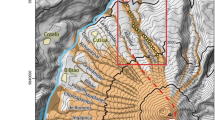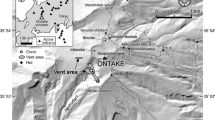Abstract
The complex eruption sequence from the ∼1000 A.D. caldera-forming eruption of Volcán Ceboruco, known as the Jala Pumice, offers an exceptional opportunity to examine how pyroclastic material is transported and deposited from pyroclastic density currents over variable topography. Three main pyroclastic surge deposits (S1, S2, and S3) and two pyroclastic flow deposits (Marquesado and North-Flank PFDs) were emplaced during this eruption. Pyroclastic surge deposits are massive, planar, or cross-bedded, poor-to-well sorted, and display fluctuations in thickness, median diameter, sorting, and lithology as a function of distance, topography, and flow dynamics. Marquesado pyroclastic flow deposits reveal lateral variations from massive, poorly sorted deposits located within 5 km of Ceboruco to planar bedded, moderately well sorted deposits located >15 km away over the nearly horizontal topography to the south of Ceboruco. North-Flank pyroclastic flow deposits also reveal lateral variations from massive, poorly sorted deposits located within 4 km of Ceboruco to planar bedded, moderately well sorted deposits located 8 km away atop an escarpment that steeply rises 230 m from the northern valley floor. Field observations, granulometric analyses, component analyses, and crystal sedimentation calculations along flow-parallel sampling transects all suggest that both surges and flows were density stratified currents, where deposition occurred from a basal region of higher particle concentration that was supplied from an overlying dilute layer that transports particles in suspension. This supports the idea of a transition between “flow” and “surge” end members with variations in particle concentration. Topography greatly affects the transport and depositional capacity of the pyroclastic density currents as a result of “blocking”, either by topographic obstacles or by abrupt breaks at the base of volcano slopes, whereas the origin of Jala Pumice surge deposits (phreatomagmatic versus magmatic) appears to have little impact on their flow dynamics.





















Similar content being viewed by others
References
Branney M, Kokelaar P (2002) Pyroclastic density currents and the sedimentation of ignimbrites. Geol Soc Lond Mem 27:152
Browne BL, Gardner JE (2004) The nature and timing of caldera collapse as indicated by accidental lithic fragments from the ∼1000 A.D. eruption of Volcán Ceboruco, Mexico. J Volcanol Geotherm Res 130:93–105
Burgisser A, Bergantz GW (2002) Reconciling pyroclastic flow and surge; the multiphase physics of pyroclastic density currents. Earth Planet Sci Lett 202:405–418
Bursik MI, Carey SN, Sparks RSJ (1992a) A gravity model for the May 18, 1980, Mount St. Helens plume. Geophys Res Lett 19:1663–1666
Bursik MI, Kurbatov AV, Sheridan MF, Woods AW (1998) Transport and deposition in the May 18, 1980, Mount St Helens blast flow. Geology 26:155–158
Bursik MI, Sparks RSJ, Gilbert JS, Carey SN (1992b) Sedimentation of tephra by volcanic plumes: I. Theory and its comparison with a study of the Fogo A Plinian deposit, Sao Miguel (Azores). Bull Volcanol 54:329–344
Bursik MI, Woods AW (1991) Buoyant, superbuoyant, and collapse eruption columns. J Volcanol Geotherm Res 45:347–350
Calder ES, Cole PD, Dade WB, Druitt TH, Hoblitt RP, Huppert HE, Ritchie L, Sparks RSJ, Young SR (1999) Mobility of pyroclastic flows and surges at the Soufriere Hills volcano, Montserrat. Geophys Res Lett 26:537–540
Carey SN (1991) Transport and deposition of tephra by pyroclastic flows and surges: sedimentation in volcanic settings. SEPM Spec Publ 45:39–57
Carey SN, Sigurdsson H (1985) The May 18, 1980 eruption of Mount St. Helens II. Modeling of dynamics of the Plinian phase. J Geophys Res 90:2948–2958
Carey SN, Sigurdsson H, Sparks RSJ (1988) Experimental studies of particle-laden plumes. J Geophys Res 93:15314–15328
Carey SN, Sigurdsson H (1989) The intensity of Plinian eruptions. Bull Volcanol 51:28–40
Carey SN, Sparks RSJ (1986) Quantitative models of the fallout and dispersal of tephra from volcanic eruption columns. Bull Volcanol 48:109–125
Cas RAF, Wright JV (1987) Volcanic successions: modern and ancient. Allen and Unwin, London
Coussot P, Proust S (1996) Slow, unconfined spreading of a mudflow. J Geophys Res 101:25217–25229
Dade WB (2003) The emplacement of low-aspect ratio ignimbrites by turbulent parent flows. J Geophys Res 108:2211–2220
Demant A (1978) Caracteristicas del Eje Neovolcanico Transmexicano y sus problemas de interpretacion. Revista - Instituto de Geologia 2:172–187
Druitt TH (1992) Emplacement of the 18 May 1980 lateral blast deposit ENE of Mount St. Helens, Washington. Bull Volcanol 54:554–572
Druitt TH (1995) Settling behaviour of concentrated dispersions and some volcanological applications. J Volcanol Geotherm Res 65:27–39
Druitt TH, Sparks RSJ (1982) A proximal ignimbrite breccia facies on Santorini volcano, Greece. J Volcanol Geotherm Res 13:147–171
Druitt TH (1998) Pyroclastic density currents. Geol Soc Lond Spec Publ 145:145–182
Ferrari L, Pasquare G, Venegas-Salgado S et al. (2000) Geology of the western Mexican volcanic belt and adjacent Sierra Madre Occidental and Jalisco Block. Geol Soc Am Bull 334:65–83
Fisher RV (1983) Flow transformations in sediment gravity flows. Geology 11:273–274
Fisher RV (1990) Transport and deposition of a pyroclastic surge across an area of high relief: the 18 May 1980 eruption of Mount St. Helens, Washington. Geol Soc Am Bull 102:1038–1054
Fisher RV, Waters AC (1970) Base surge bedforms in maar volcanoes. Am J Sci 268:157–180
Fisher RV, Heiken GH (1982) Mt Pelée, Martinique: May 8 and 20 pyroclastic flows and surges. J Volcanol Geotherm Res 13:339–371
Fisher RV, Heiken GH (1983) Mt Pelée, Martinique: May 8 and 20 pyroclastic flows and surges—reply. J Volcanol Geotherm Res 19:180–184
Fujii T, Nakada S (1999) The 15 September 1991 pyroclastic flows at Unzen Volcano (Japan): a flow model for associated ash-cloud surges. J Volcanol Geotherm Res 89:159–172
Gardner JE, Tait S (2000) The caldera-forming eruption of Volcán Ceboruco, Mexico. Bull Volcanol 62:20–33
Gray JMNT, Tai YC, Noelle S (2003) Shock waves, dead zones, and particle-free regions in rapid granular free-surface flows. J Fluid Mech 491:161–181
Gunn B, Mooser F (1971) Geochemistry of the volcanics of central Mexico. Bull Volcanol 34:577–614
Macias JL, Sheridan MF, Espindola JM (1997) Reappraisal of the 1982 eruptions of El Chichón Volcano, Chiapas, Mexico: new data from proximal deposits. Bull Volcanol 58:459–471
Macias JL, Espindola JM, Bursik MI, Sheridan MF (1998) Development of lithic-breccias in the 1982 pyroclastic flow deposits of El Chichón Volcano, Mexico. J Volcanol Geotherm Res 83:173–196
Moore JG (1967) Base surge in recent volcanic eruptions. Bull Volcanol 30:332–363
Moore JG, Peck DL (1962) Accretionary lapilli in volcanic rocks of the western United States. Geology 70:182–193
Moore G, Marone C, Carmichael ISE, Renne P (1994) Basaltic volcanism and extension near the intersection of the Sierra Madre volcanic province and the Mexican Volcanic Belt. Geol Soc Am Bull 106:383–394
Nelson SA (1980) Geology and petrology of Volcán Ceboruco, Nayarit, Mexico. Geol Soc Am Bull 91:2290–2431
Self S, Sparks RSJ (1978) Characteristics of widespread pyroclastic deposits formed by the interaction of silicic magma and water. Bull Volcanol 41:196–212
Sparks RSJ (1976) Grain-size variations in ignimbrites and implications for the transport of pyroclastic flows. Sedimentology 23:147–188
Sparks RSJ (1986) The dimensions and dynamics of volcanic eruption columns. Bull Volcanol 48:3–15
Sparks RSJ, Wilson CJH (1976) A model for the formation of ignimbrite by gravitational column collapse. J Geol Soc Lond 132:441–452
Sparks RSJ, Carey SN, Sigurdsson H (1991) Sedimentation from gravity currents generated by turbulent plumes. Sedimentology 38:839–856
Sparks RSJ, Bursik MI, Ablay GJ, Thomas RME, Carey SN (1992) Sedimentation of tephra by volcanic plumes. Part II: controls on thickness and grain-size variations of tephra fall deposits. Bull Volcanol 54:685–695
Thorpe RS, Francis PW (1975) Volcán Ceboruco: a major composite volcano of the Mexican Volcanic Belt. Bull Volcanol 39:201–213
Valentine GA (1987) Stratified flow in pyroclastic surges. Bull Volcanol 49:616–630
Walker GPL (1971) Grain-size characteristics of pyroclastic deposits. Geology 79:696–714
Walker GPL (1973) Explosive volcanic eruptions—a new classification scheme. Geol Rundsch 62:431–446
Walker GPL (1981) Plinian eruptions and their products. Bull Volcanol 44:223–240
Walker GPL (1983) Ignimbrite types and ignimbrite problems. J Volcanol Geotherm Res 17:65–88
Walker GPL, McBroome LA (1983) Mount St. Helens 1980 and Mount Pelée 1902—flow or surge? Geology 11:571–574
Waters AC, Fisher RV (1971) Base surges and their deposits: Capelinhos and Taal volcanoes. J Geophys Res 76:5596–5614
Wilson CJH (1980) The role of fluidization in emplacement of pyroclastic flows: an experimental approach. J Volcanol Geotherm Res 8:231–249
Wilson CJH (1984) The role of fluidization in emplacement of pyroclastic flows II, experimental results and their interpretations. J Volcanol Geotherm Res 8:55–84
Wilson CJH (1985) The Taupo eruption, New Zealand: II. The Taupo ignimbrite. Phil Trans R Soc Lond 314:229–310
Wilson CJH, Walker GPL (1982) Ignimbrite depositional facies: the anatomy of a pyroclastic flow. J Geol Soc Lond 139:581–592
Woods AW, Bursik MI (1994) A laboratory study of ash flows. J Geophys Res 99:4375–4394
Woods AW, Bursik MI, Kurbatov AV (1998) The interaction of ash flows with ridges. Bull Volcanol 60:38–51
Acknowledgements
We thank Ricardo Saucedo and Jose Luis Arce for their gracious assistance and cooperation during fieldwork and in subsequent discussions of this study. We are also thankful for the insightful discussions with Alexander Belousov, George Bergantz, Carrie Browne, Alain Burgisser, John Eichelberger, Luca Ferrari, Pavel Izbekov, Jessica Larsen, Jose Luis Macias, and Steven Nelson that greatly improved this manuscript. Finally, we thank Dave Pyle and Steven Carey for their thoughtful and constructive reviews.
Author information
Authors and Affiliations
Corresponding author
Additional information
Editorial responsibility: A.W. Woods
An erratum to this article is available at http://dx.doi.org/10.1007/s00445-007-0169-7.
Rights and permissions
About this article
Cite this article
Browne, B.L., Gardner, J.E. Transport and deposition of pyroclastic material from the ∼1000 A.D. caldera-forming eruption of Volcán Ceboruco, Nayarit, Mexico. Bull Volcanol 67, 469–489 (2005). https://doi.org/10.1007/s00445-004-0390-6
Received:
Accepted:
Published:
Issue Date:
DOI: https://doi.org/10.1007/s00445-004-0390-6




